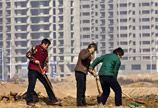

China's cabinet approved the establishment of new zones in Northwest China's Shaanxi and Guizhou provinces in the southwest, the latest move to open up inland regions.
Urbanization in China should adopt a more people-oriented approach with greater efforts to guarantee equal access to public services.
 Urbanization is still an integral element of China's growth agenda and policymakers should strive to push for steady, gradual results, rather than quick solutions.
Urbanization is still an integral element of China's growth agenda and policymakers should strive to push for steady, gradual results, rather than quick solutions.
 China's urbanization rate is expected to hit 60 percent by 2018 at the current rate of urbanization, according to a blue book released on Thursday.
China's urbanization rate is expected to hit 60 percent by 2018 at the current rate of urbanization, according to a blue book released on Thursday.
A survey conducted by Renmin University of China showed that the top three concerns of the Chinese are housing, medical care and commodity prices.
 China's new approach to urbanization has made the year 2013 a turning point, especially for the 260 million migrant workers who await the benefits of the change.
China's new approach to urbanization has made the year 2013 a turning point, especially for the 260 million migrant workers who await the benefits of the change.
The country's rural reform has accelerated, with more detailed and far-reaching plans expected to be rolled out this week.
The greatest risk China faces in its historic modernization is the massive imbalance between urban and rural areas.
Air pollution is only one of the symptoms of the imperfect growth model which favored GDP growth over every other factor, including environmental benefit.
A blueprint for urbanization with an axis of mega cities was unveiled in China. Experts expect 32 mega cities will be completed by 2030.
Measures are being taken to enable China's 260 million migrant workers to gain urbanite status and become integrated members of cities.
Urbanization, a key driver of China's economic growth, is expected to accelerate in the coming year and usher in a new round of investment.